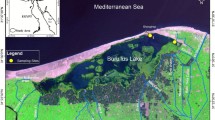Synopsis
Young fish of six species in an open water community all began their exogenous feeding by taking nauplii and small cyclopoids of body length (less tail) of 0.1–0.3 mm. Appearance of larvae of the different species in the system was, however, sequential, the resource being utilized by the different species in turn. The sequence was: Perca flavescens, Percina caprodes, Pomoxis nigromaculatus, Ambloplites rupestris, Lepomisgibbosus and L. macrochirus.
The larvae and juveniles changes their diet rapidly as they grew. Fish 10–14 days after hatching and 8–10 mm in length i.e. close to the beginning of the juvenile period, consumed larger-bodied prey items (including several genera of Cladocera) and had more diversified diets than the 4.5–6.0 mm first-feeding larvae. These differences, and progressive dispersal of the larger young from the area, served to minimize the chances of food competition between batches of young of different ages.
The composition of the fish community of larvae changed from week to week as new species entered it, increased in size and departed. Patterns of food utilization changed accordingly.
Numbers of cyclopoids, their nauplii, and Bosmina longirostris, fell rapidly in May — early June, and did not increase again until August. These changes coincided with the rise and fall in numbers of the young fish in the habitat.
Similar content being viewed by others
References cited
Allanson, B. R. & J. E. Kerrich. 1961. A statistical method for estimating the numbers of animals found in field samples drawn from polluted rivers. Verh. Internat. Verein. Limnol. 14: 491–494.
Amundrud, J. R., D. J. Faber & A. Keast. 1974. Seasonal succession of free-swimming perciform larvae in Lake Opinicon, Ontario. J. Fish. Res. Board Can. 31: 1661–1665.
Balon, E. K. 1975. Terminology of intervals in fish development. J. Fish. Res. Board Canada 32: 1663–1670.
Brooks, J. L. & S. I. Dodson, 1965. Predation, body size, and composition of plankton. Science 150: 28–35.
Faber, D. 1967. Limnetic larval fish in northern Wisconsin lakes. J. Fish. Res. Board Can. 24: 927–937.
Keast, A. 1977. Mechanisms expanding niche width and minimizing intraspecific competition in the rock bass and bluegill sunfish (Centrarchidae). Evol. Biol. 10: 333–395.
Levins, R. 1968. Evolution in changing environments. Princeton Univ. Press, Princeton, New Jersey. 120 pp.
May, R. M. 1975. Some notes on estimating the competition matrix. Ecology 56: 737–741.
Noble, R. 1970. An evaluation of the Miller high-speed sampler for sampling yellow perch and walleye fry. J. Fish Res. Board Can. 27: 1033–1044.
Sheri, A. N. & G. Power. 1969. Fecundity of the yellow perch, Perca flavescens (Mitchell) in the Bay of Quinte, Lake Ontario. Can. J. Zool. 47: 55–58.
Shannon, C. E. & W. Weaver. 1963. The mathematical theory of communication. University of Illinois Press. 150 pp.
Werner, R. G. 1967. Intralacustrine movements of bluegill fry in Crane Lake, Indiana. Trans. Amer. Fish. Soc. 96: 416–420.
Werner, R. G. 1969. Ecology of limnetic bluegill (Lepomis macrochirus) fry in Crane Lake, Indiana. Amer. Midl. Natur. 81: 164–181.
Author information
Authors and Affiliations
Additional information
Paper presented in the symposium \lsEmbryonic and larval periods of fishes: present status and significance\rs, Canadian Conference for Fisheries Research (CCFFR), Fredricton, New Brunswick, January 1977.
Rights and permissions
About this article
Cite this article
Keast, A. Food and feeding relationships of young fish in the first weeks after the beginning of exogenous feeding in Lake Opinicon, Ontario. Environ Biol Fish 5, 305–314 (1980). https://doi.org/10.1007/BF00005185
Received:
Accepted:
Issue Date:
DOI: https://doi.org/10.1007/BF00005185




